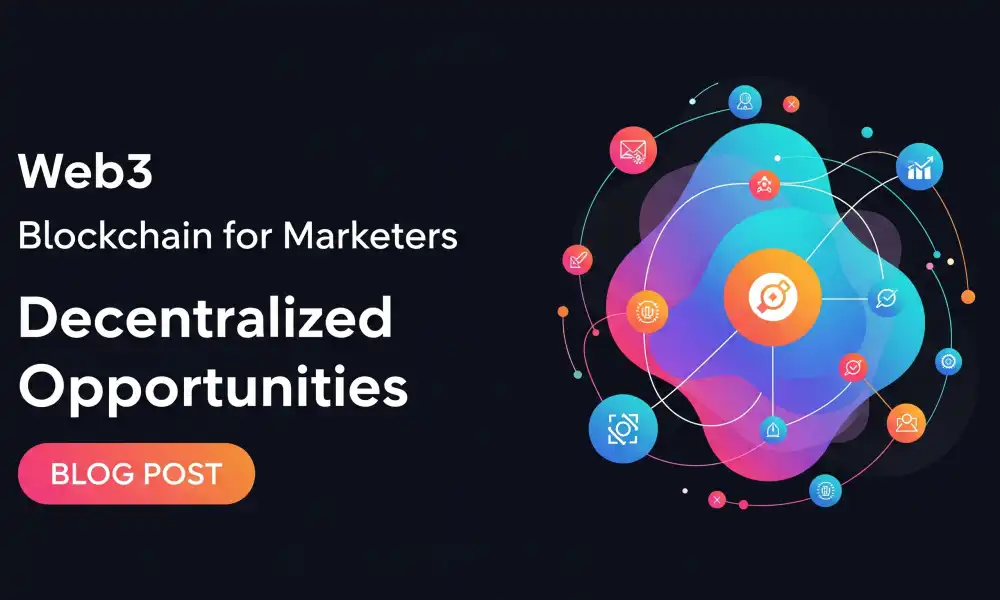Web3 and Blockchain for Marketers: Decentralized Opportunities in 2025
Through Web3, you're not just building loyalty—you're building trust, one transparent step at a time.
The digital marketing landscape is perpetually shifting, but if 2024 was about embracing AI, 2025 is the year marketers truly begin to grapple with the decentralized revolution promised by Web3 and blockchain technology. This isn't just about cryptocurrencies and NFTs; it's about fundamentally rethinking how brands connect with consumers, build trust, and manage data in a permissionless, transparent, and user-centric internet.
For too long, Web2 has seen massive tech giants control user data, advertising networks, and content distribution. While convenient, this centralized model has led to privacy concerns, ad fraud, and a lack of true ownership for both creators and consumers. Web3, built on blockchain, offers a compelling alternative – a more equitable, secure, and transparent digital ecosystem.
So, how exactly can marketers leverage these decentralized opportunities in 2025?
1. Reclaiming Trust Through Transparency
One of blockchain's most powerful attributes is its immutable and transparent ledger. For marketers, this translates into unprecedented levels of trust.
- Ad Fraud Prevention: Billions are lost to ad fraud annually. Blockchain can verify every impression and click, ensuring advertisers pay for genuine engagement. Imagine a future where every ad interaction is recorded on a transparent ledger, making it virtually impossible for bots or fraudulent activities to skew campaign results.
- Supply Chain Transparency: For brands focused on ethical sourcing or sustainability, blockchain can provide verifiable proof of a product's journey from raw materials to consumer. This builds immense trust and resonates deeply with today's conscious consumers.
- Verifiable Data Insights: While respecting user privacy (more on this below), blockchain can enable more accurate and verifiable data collection, allowing marketers to truly understand consumer behavior without relying on opaque third-party aggregators.
2. Empowering Users with Data Ownership (and Better Personalization)
The "cookieless future" is upon us, forcing marketers to rethink data collection. Web3 offers a solution by putting data ownership back into the hands of users.
- Zero- and First-Party Data: Instead of collecting data without explicit consent, Web3 encourages models where users willingly share data they choose, often in exchange for value (e.g., tokens, exclusive content). This "zero-party" data (data intentionally shared by the consumer) and direct "first-party" data are infinitely more valuable and reliable.
- Consent Management: Blockchain-based consent management platforms can give users granular control over their personal information. Marketers can build trust by demonstrating clear, auditable consent mechanisms, making consumers more likely to engage.
- Personalized Experiences: With truly opted-in data, marketers can deliver hyper-personalized experiences that are genuinely relevant, rather than broadly targeted based on inferred data.
3. Community Building and Loyalty Programs on Steroids
Web3 fosters strong, engaged communities. This is a goldmine for marketers looking to build brand loyalty.
- Tokenized Loyalty Programs: Forget traditional points systems. Brands can issue their own fungible tokens or even NFTs as loyalty rewards. These tokens can offer real utility – access to exclusive products, voting rights in brand decisions (through Decentralized Autonomous Organizations or DAOs), or even discounts. This creates a stronger sense of ownership and belonging.
- Decentralized Social Media & Forums: As users move away from centralized social platforms, marketers need to engage in decentralized spaces like Discord, Telegram, and emerging Web3 social networks. These platforms allow for more direct, unmediated conversations and community governance.
- NFTs for Engagement & Gating: NFTs aren't just digital art. Brands are using them as digital keys for exclusive content, event access, or even fractional ownership in a brand asset. This creates unique, memorable experiences and fosters deeper connections with superfans.
4. Direct-to-Consumer (D2C) & Creator Economy Amplification
Blockchain's ability to remove intermediaries directly benefits D2C brands and creators.
- Direct Transactions: Smart contracts on the blockchain can automate transactions and agreements directly between brands and consumers, cutting out costly middlemen and enabling creators to earn a larger share of revenue.
- Creator Monetization: Marketers can collaborate with Web3 content creators who own their audience and intellectual property, enabling more equitable partnerships and innovative co-creation models.
- Fractional Ownership & Investment: Imagine a fashion brand allowing its most loyal customers to own a fraction of a new design via NFTs, giving them a stake in its success. This blurs the lines between consumer and investor, building unprecedented loyalty.
The Road Ahead: Challenges and Opportunities
While the potential of Web3 and blockchain in marketing is immense, it's not without its challenges. Technological complexity, user education, and regulatory uncertainties are still significant hurdles. However, for marketers willing to learn, experiment, and embrace a decentralized mindset, the opportunities for enhanced transparency, deeper trust, genuine community engagement, and innovative customer experiences are unparalleled in 2025 and beyond.






Write a Comment
0 Comments
Please Login or Register to comment.